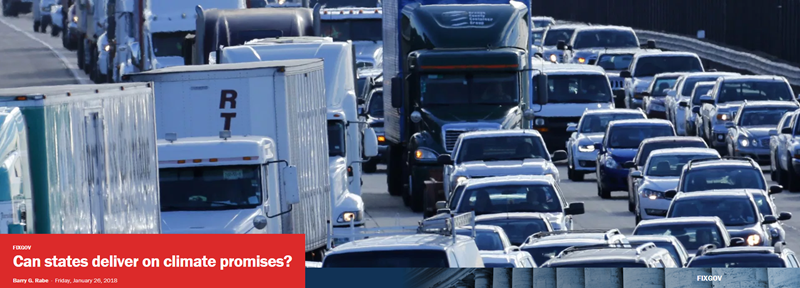
Can states deliver on climate promises?
Barry G. Rabe
Friday, January 26, 2018
One of the great challenges in climate policy remains translation of lofty pledges and proclamations into actual policy that is subsequently launched, proves sustainable over time, and ultimately delivers on its expected performance goals. The two decades following the Kyoto Protocol feature some major achievements in carbon pricing and other mitigation policies. But they are also littered with numerous failures and reversals in the United States and beyond.
This story line is broadly applicable around the world but is particularly telling in the American case. It is reflected in the Trump Administration’s efforts to reverse virtually every climate initiative undertaken by the Obama Administration, including planned emission reductions for carbon in the electricity sector and methane from oil and gas extraction. Once again, we see the limits of executive-driven actions that lack legislative branch buy-in and face the enduring political challenge of developing durable climate policy.
These federal reversals have stirred much public outcry by governors and attorneys general in a number of states. During the first year of the Trump presidency, we have seen a dizzying number of new state-based declarations of intent to maintain and expand on prior reduction commitments. “We’re still in” has become a rallying cry among a great many states, localities, firms, and universities, backed by a large set of petitions and summits.
But the track record of actual translation of those exhortations into formal policy commitments is highly uneven thus far. Both California and the nine states of the Regional Greenhouse Gas Initiative (RGGI) have now extended and intensified earlier policies. However, relatively little new climate-friendly policy was adopted during legislative sessions in most other statehouses during 2017. This suggested a possible pattern whereby states that were already leading a national effort (and had long since achieved low per capita emissions) were doubling down on prior plans. But it also indicated a strong possibility that the climate chorus of engaged states was not necessarily expanding.
2018 thus provides an important test of just what happens if we are returning to a more state-centered climate policy arena. Many legislatures have returned recently to their capitals and will be making key decisions in the coming months. At least four areas present particular challenges and opportunities:
Carbon Pricing: RGGI and California have long hungered for more state partners, having lost a number of states between 2008 and 2010 that had pledged fealty to regional cap-and-trade just a few years earlier. During the last decade, the only new North American entrants into cap-and-trade are the Canadian provinces of Quebec and Ontario. But the 2017 election seemingly augurs well in 2018 for states such as New Jersey, Oregon, Virginia, and Washington to rescind their earlier reversals and expand the carbon pricing network. Carbon tax legislation has been introduced again in at least six states, despite the decisive rejection of a 2016 ballot proposition in Washington. Can the scope of state carbon pricing expand and will legislators back what supportive governors have pledged to do?
Credit : https://www.brookings.edu/blog/fixgov/2018/01/26/can-states-deliver-on-climate-promises/


































